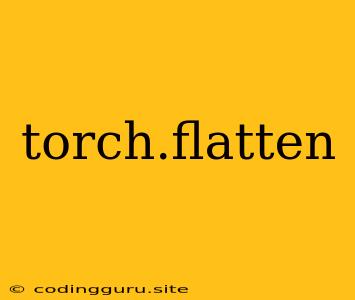Understanding the Power of torch.flatten in PyTorch: A Comprehensive Guide
PyTorch is a powerful deep learning framework that provides a wide range of tools for building and training neural networks. Among these tools, the torch.flatten function plays a crucial role in reshaping and manipulating tensor data, making it a fundamental concept for any PyTorch practitioner.
In this guide, we'll delve into the intricacies of torch.flatten and explore how it empowers you to streamline your PyTorch operations. We'll cover its functionalities, practical applications, and best practices to ensure you gain a thorough understanding of this valuable function.
What is torch.flatten?
At its core, torch.flatten is a PyTorch function that transforms a multi-dimensional tensor into a one-dimensional vector, essentially collapsing all dimensions into a single axis. This reshaping operation is often essential when preparing data for specific layers in your neural network, such as fully connected layers that expect a flattened input.
Why Use torch.flatten?
You might be wondering why torch.flatten is so important. Here are some compelling reasons:
-
Preparing Data for Fully Connected Layers: Fully connected layers in neural networks operate on vectors.
torch.flattenensures that your input data is in the correct format before it is fed into these layers. -
Simplifying Operations: By collapsing dimensions,
torch.flattencan simplify certain calculations and make it easier to work with your data. -
Flexibility in Dimension Control:
torch.flattenallows you to specify the dimension you want to flatten, providing you with precise control over your tensor's structure.
How Does torch.flatten Work?
The syntax for using torch.flatten is straightforward:
torch.flatten(input, start_dim=0, end_dim=-1)
input: The tensor you want to flatten.start_dim: The starting dimension to flatten (default is 0, meaning all dimensions are flattened).end_dim: The ending dimension to flatten (default is -1, meaning all dimensions fromstart_dimto the end are flattened).
Examples of torch.flatten in Action
Let's illustrate how torch.flatten works with some practical examples:
Example 1: Flattening a 2D Tensor
import torch
x = torch.tensor([[1, 2], [3, 4]]) # Create a 2D tensor
# Flatten the entire tensor
x_flat = torch.flatten(x)
print(x_flat) # Output: tensor([1, 2, 3, 4])
Example 2: Flattening Specific Dimensions
import torch
x = torch.tensor([[[1, 2], [3, 4]], [[5, 6], [7, 8]]]) # Create a 3D tensor
# Flatten from dimension 1 to the end
x_flat = torch.flatten(x, start_dim=1)
print(x_flat) # Output: tensor([[1, 2, 3, 4], [5, 6, 7, 8]])
# Flatten from dimension 0 to dimension 1
x_flat = torch.flatten(x, start_dim=0, end_dim=1)
print(x_flat) # Output: tensor([[1, 2], [3, 4], [5, 6], [7, 8]])
Tips and Best Practices
Here are some essential tips to enhance your usage of torch.flatten:
-
Understand your data: Before using
torch.flatten, ensure you have a clear understanding of your tensor's shape and the desired output structure. -
Choose the right dimensions: Select the
start_dimandend_dimvalues carefully based on your specific flattening requirements. -
Consider
reshapeandview: Whiletorch.flattenis efficient for flattening tensors, in some cases,torch.reshapeortorch.viewmay be more appropriate for creating specific tensor shapes.
Conclusion
torch.flatten is an indispensable tool in the PyTorch arsenal. By understanding its functionality and applying it effectively, you can streamline your data manipulation, optimize your neural network architectures, and achieve better performance in your deep learning tasks. Remember to choose the appropriate dimensions and explore alternative reshaping methods when needed.
